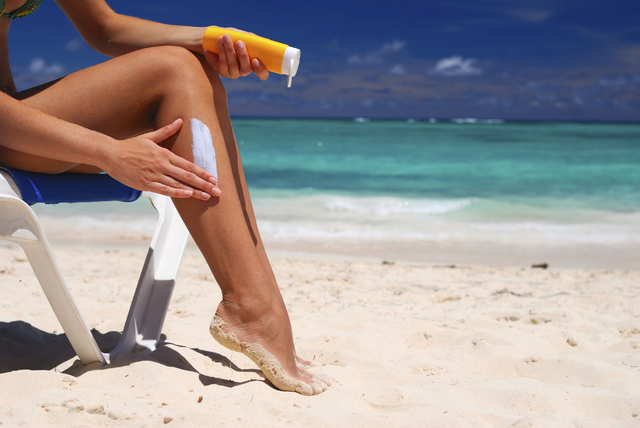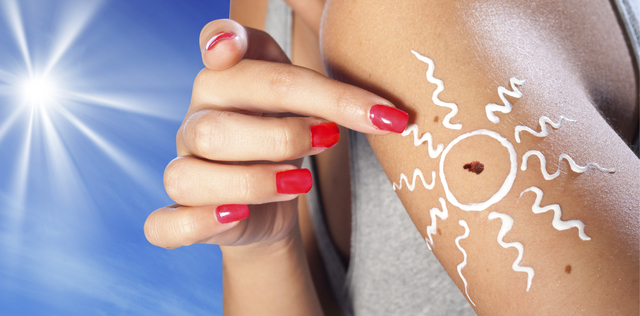12 mistakes you’re making about skin cancer


You go swimming in your neighbor’s pool. You spend part of your day outside for a soccer game (or two). You take the boat out to the lake for the day.
In all these scenarios, you’re spending time in the sun, most likely between the hours of 10 a.m. and 4 p.m. Did you apply your sunscreen and regularly reapply throughout the day? Did you wear sunglasses, a hat and seek shade?
If you said no, you’re not alone. More than one-third of adults reported having a sunburn in 2008, according to the Centers for Disease Control. Only 32 percent of adults said they put on sunscreen when they went outside for an hour or more. The results are even more dismal for teens. About 14 percent of teen girls and 7.3 percent of teen boys reported using sunscreen when they’re outside.
And it’s not for a lack of knowledge. Media outlets, doctors and advocates always say that in order to prevent skin cancer, you need to wear sunscreen and sun protective clothing and gear and seek shade.
Despite knowing all this, people still get sunburns regularly. What is the biggest problem when it comes to preventing skin cancer?
Thinking you’re invincible
Skin cancer is a national epidemic, said Dr. Michael Hinckley from the Granger Medical Clinic. And the biggest problem when it comes to skin cancer prevention is it’s hard to make people “believers.”
“There’s a sense of invincibility in young people,” Hinckley said. “And that’s when so much of our damage occurs.”
It’s hard to make people take skin cancer seriously, even when presented with the horrific facts, Hinckley said.
Not using sun protection correctly
And on top of people not caring, they’re not using sun protection appropriately. Sunburns and cumulative sun damage over time can become an issue, Hinckley said. You get sun damage when you sit outside for a few minutes or drive to and from work. You can also get sun damage when you’re inside near windows.
You’re also probably not using enough sunscreen, which reduces your protection drastically. If you’re going to be outside, you should be using enough sunscreen to fill up a shot glass, or between 2-3 tablespoons, Hinckley said.
And when it comes to SPF, the higher the better, he said.
“None of us are lab rats. If you’re in a controlled environment, SPF 30 is pretty good,” he said. “The reality is, people put on half or one-fourth as much as they need.”
He recommends people using SPF 50 or 100, to make sure you’re extra-protected if you don’t put on enough.
It’s not too late
Here’s some good news: Even if you had extensive sun damage in your youth, it’s not too late.
“Unless you’re 95, you can still get some benefit,” Hinckley said.
Any damage you do now will affect you in the future, he said, so any time you can stop being in the sun without protection will still benefit your skin. You may still get skin cancer, but you can save yourself from getting even more, while lowering your risk.
You know the drill: Get into the habit of putting on sunscreen in the morning. Use protective clothing and gear and find shady spots if you’re going to be outside from 10 a.m. to 4 p.m.
Find a sunscreen you’ll use and stick with it
But how do you get into the habit of using sunscreen? The thought of putting on sunscreen every day for the rest of your life can seem like a daunting, overwhelming task.
The best way to get into the habit of using a sunscreen is to find one you like to use. There are many different options on the market that won’t leave you with a pasty white residue, he said.
Hinckley he uses a Neutrogena facial sunscreen with Helioplex, which is a chemical sunscreen, on his face every day. He uses a zinc sunscreen for other exposed areas of his body.
And despite ease of use, spray sunscreens can be dangerous when inhaled, Hinckley said. If you’re going to use them, especially on kids, step away while you spray it on your hands, then put it on.
Best protection doesn’t come from a bottle
“Barriers are better than sunscreen. This includes a hat, sun protective clothing, swim shirts,” Hinckley said. “It’s so much easier to wear a swim shirt than to slather on sunscreen every couple hours.”
Everyday clothing can also protect you from the sun. Blue jeans have an ultraviolet protection rating (UPF) of 1700. You can also wash your clothes with a UV-blocking additive like Rit SunGuard that will increase the UPF of your clothing, according to skincancer.org.
Despite all the warnings, people don’t have to always avoid the sun, he said.
“I don’t want people to change their lifestyle,” Hinckley said. “There has to be a balance. You don’t need to hide out in the basement when the sun’s out. … If you have to be outside, do your best to cover up.”
And if you’re worried about a Vitamin D deficiency?
“Vitamin D is easy and cheap to get,” he said, adding he takes a small supplement every day. “We don’t need to worry about a deficiency any more.”
Early detection of cancer
Skin cancer is the most common of all the cancers, but it’s also the easiest to cure. The Skin Cancer Foundation recommends people perform a monthly head-to-toe self-examination. If you see spots, moles or freckles that are new or changing, see a doctor.![]() You go swimming in your neighbor’s pool. You spend part of your day outside for a soccer game (or two). You take the boat out to the lake for the day.
You go swimming in your neighbor’s pool. You spend part of your day outside for a soccer game (or two). You take the boat out to the lake for the day.
In all these scenarios, you’re spending time in the sun, most likely between the hours of 10 a.m. and 4 p.m. Did you apply your sunscreen and regularly reapply throughout the day? Did you wear sunglasses, a hat and seek shade?
If you said no, you’re not alone. More than one-third of adults reported having a sunburn in 2008, according to the Centers for Disease Control. Only 32 percent of adults said they put on sunscreen when they went outside for an hour or more. The results are even more dismal for teens. About 14 percent of teen girls and 7.3 percent of teen boys reported using sunscreen when they’re outside.
And it’s not for a lack of knowledge. Media outlets, doctors and advocates always say that in order to prevent skin cancer, you need to wear sunscreen and sun protective clothing and gear and seek shade.
Despite knowing all this, people still get sunburns regularly. What is the biggest problem when it comes to preventing skin cancer?
Thinking you’re invincible
Skin cancer is a national epidemic, said Dr. Michael Hinckley from the Granger Medical Clinic in Salt Lake County. And the biggest problem when it comes to skin cancer prevention is it’s hard to make people “believers.”
“There’s a sense of invincibility in young people,” Hinckley said. “And that’s when so much of our damage occurs.”
It’s hard to make people take skin cancer seriously, even when presented with the horrific facts, Hinckley said.
Not using sun protection correctly
And on top of people not caring, they’re not using sun protection appropriately. Sunburns and cumulative sun damage over time can become an issue, Hinckley said. You get sun damage when you sit outside for a few minutes or drive to and from work. You can also get sun damage when you’re inside near windows.
You’re also probably not using enough sunscreen, which reduces your protection drastically. If you’re going to be outside, you should be using enough sunscreen to fill up a shot glass, or between 2-3 tablespoons, Hinckley said.
And when it comes to SPF, the higher the better, he said.
“None of us are lab rats. If you’re in a controlled environment, SPF 30 is pretty good,” he said. “The reality is, people put on half or one-fourth as much as they need.”
He recommends people using SPF 50 or 100, to make sure you’re extra-protected if you don’t put on enough.
It’s not too late
Here’s some good news: Even if you had extensive sun damage in your youth, it’s not too late.
“Unless you’re 95, you can still get some benefit,” Hinckley said.
Any damage you do now will affect you in the future, he said, so any time you can stop being in the sun without protection will still benefit your skin. You may still get skin cancer, but you can save yourself from getting even more, while lowering your risk.
You know the drill: Get into the habit of putting on sunscreen in the morning. Use protective clothing and gear and find shady spots if you’re going to be outside from 10 a.m. to 4 p.m.
Find a sunscreen you’ll use and stick with it
But how do you get into the habit of using sunscreen? The thought of putting on sunscreen every day for the rest of your life can seem like a daunting, overwhelming task.
The best way to get into the habit of using a sunscreen is to find one you like to use. There are many different options on the market that won’t leave you with a pasty white residue, he said.
Hinckley he uses a Neutrogena facial sunscreen with Helioplex, which is a chemical sunscreen, on his face every day. He uses a zinc sunscreen for other exposed areas of his body.
And despite ease of use, spray sunscreens can be dangerous when inhaled, Hinckley said. If you’re going to use them, especially on kids, step away while you spray it on your hands, then put it on.
Best protection doesn’t come from a bottle
“Barriers are better than sunscreen. This includes a hat, sun protective clothing, swim shirts,” Hinckley said. “It’s so much easier to wear a swim shirt than to slather on sunscreen every couple hours.”
Everyday clothing can also protect you from the sun. Blue jeans have an ultraviolet protection rating (UPF) of 1700. You can also wash your clothes with a UV-blocking additive like Rit SunGuard that will increase the UPF of your clothing, according to skincancer.org.
Despite all the warnings, people don’t have to always avoid the sun, he said.
“I don’t want people to change their lifestyle,” Hinckley said. “There has to be a balance. You don’t need to hide out in the basement when the sun’s out. … If you have to be outside, do your best to cover up.”
And if you’re worried about a Vitamin D deficiency?
“Vitamin D is easy and cheap to get,” he said, adding he takes a small supplement every day. “We don’t need to worry about a deficiency any more.”
Early detection of cancer
Skin cancer is the most common of all the cancers, but it’s also the easiest to cure. The Skin Cancer Foundation recommends people perform a monthly head-to-toe self-examination. If you see spots, moles or freckles that are new or changing, see a doctor.



















